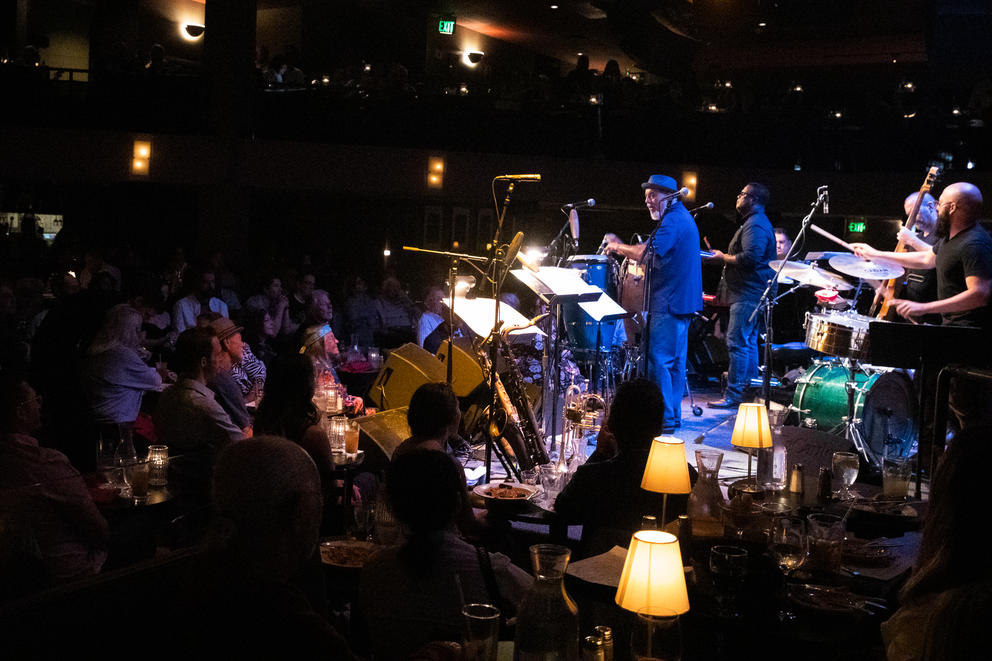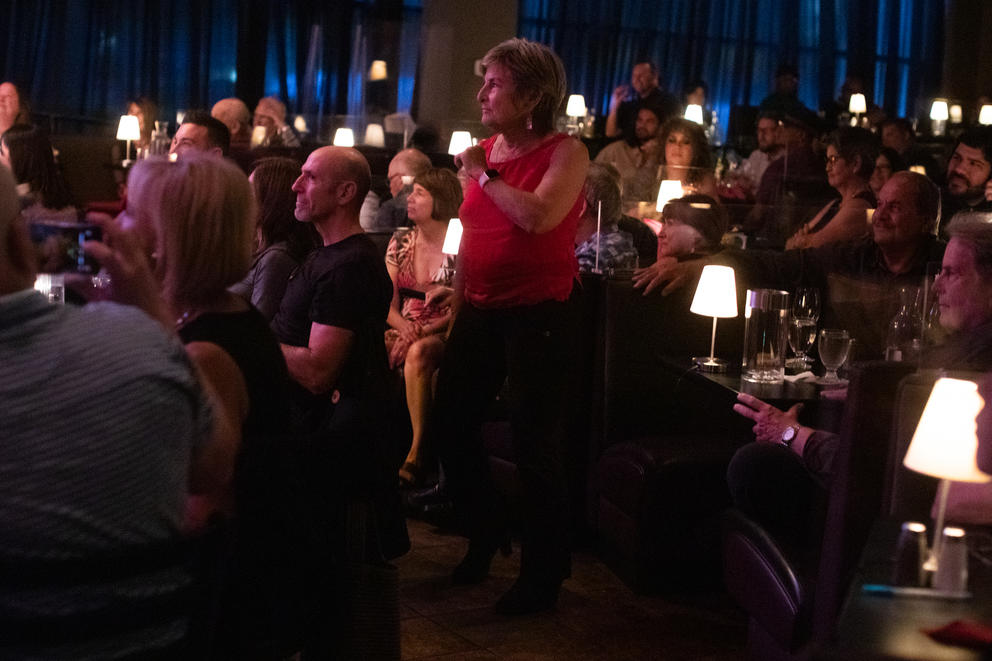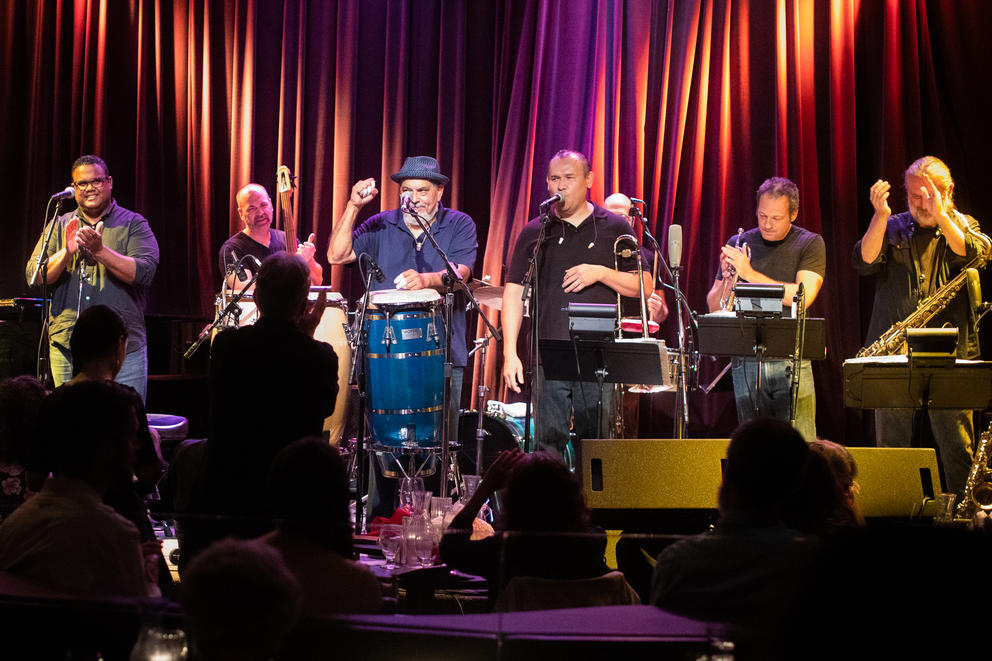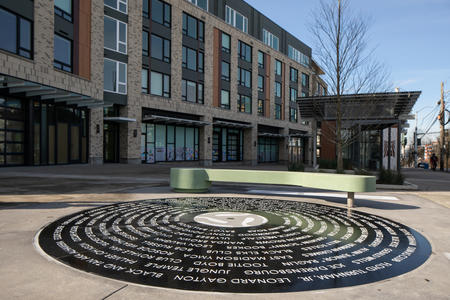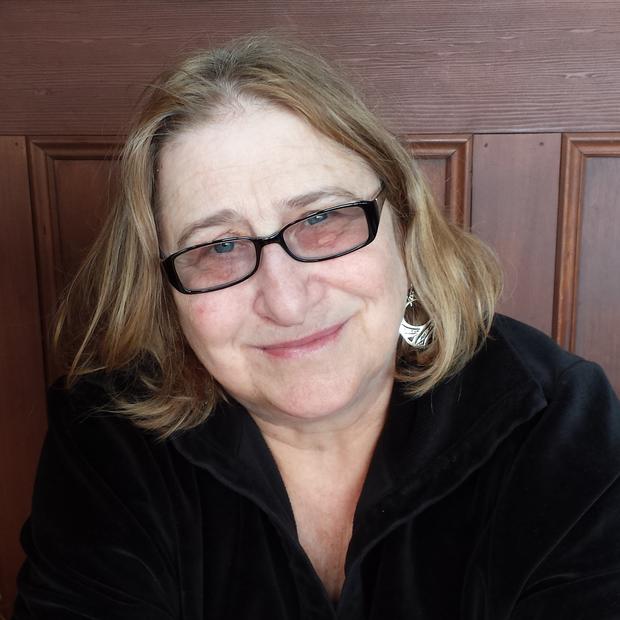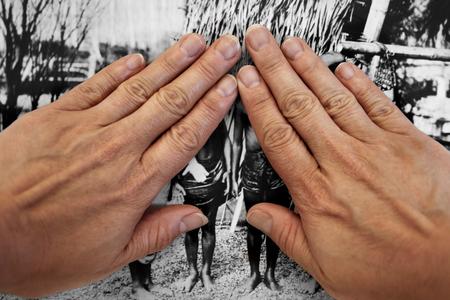Dimitriou’s Jazz Alley was opening a two-night run by the nationally known, Seattle-based gypsy jazz ensemble Pearl Django. It was one of the first in-the-flesh concerts in well over a year at the beloved nightclub — one of the city’s first venues to resume in-person shows — since Washington state closed all live music venues in March 2020 because of the COVID-19 pandemic.
During the show (in late June), the only obvious updates at Jazz Alley were the new air circulation system and plexiglass dividers between tables, so unobtrusive they hardly seemed like barriers. More notable was the palpable sense of celebration from club manager Ari Dimitriou, the beaming musicians and the highly responsive audience. As the band’s “le jazz hot” accordion- and jazz-laced tunes lilted and flowed, the crowd was near-ecstatic.
“With everyone forced to hang out at home for the last 16 months, I feel like people are so glad just to be hearing and making music,” says Pearl Django violinist and band leader Michael Gray. “I think people are starving for that connection. We already have nine, ten gigs set up in August. And we have some touring booked in September and October.”
A woman dances to music performed by the Poncho Sánchez Latin Jazz Band during one of the first post-pandemic concerts at Dimitriou’s Jazz Alley in Seattle on July 8, 2021. The packed house and enthusiastic crowd reflects an audience eager for the return of in-person concerts. (Matt M. McKnight/Crosscut)
Jazz vocalist and teacher Greta Matassa, a respected veteran of the local jazz scene, was initially unsure how quickly dates would come her way after going so long without a live gig. “I thought I’d just start knocking on doors and see what happens,” she says. “Before this it was just livestreams once or twice a month.”
But Matassa was happily surprised how fast her calendar filled up. “The first live gig we did was in May at Lake Chelan Jazz Festival, outdoors in front of a large audience, she says. “Then recently we had a sold-out, indoor Jazz Alley date. I stepped out on the stage and there were a couple hundred people, all maskless. It was such a lovefest.”
While rock, hip-hop and other musical artists have also been uncertain about what to expect after restrictions on in-person shows were lifted, those in Seattle’s vibrant jazz scene had special reasons for concern.
Recorded jazz on all platforms (disc, streaming, vinyl) now constitutes only about 1.1% of the music market nationally, making live shows absolutely essential to the art form’s survival. And by its very definition, this American-rooted art form thrives on the spontaneity, improvisation and bursts of virtuosity that make each night on the bandstand unpredictable and unique. It also relies on an impromptu dynamic between the musicians and the live audience that feeds the music — and doesn’t translate to Zoom.
Though it is welcomed periodically in symphony auditoriums like Benaroya Hall, and large showplaces like the Paramount Theatre, jazz has mostly flourished in intimate spaces — clubs, restaurants and bars, which often operate on a profit margin that’s either slender or nonexistent.
But as real estate values have skyrocketed across the Puget Sound region over the past decade, with waves of new apartment construction replacing smaller “legacy” businesses in Seattle’s downtown core and residential neighborhoods, the constellation of local jazz venues has seemed more fragile.
In 2019, the popular Tula's Restaurant and Jazz Club, a major purveyor of local talent, closed a 26-year run in Belltown because of rising costs and redevelopment. Small, quirky and cherished holes in the wall that are friendly to live and experimental jazz — such as Wallingford’s Sea Monster Lounge and the University District’s Cafe Racer — struggled to stay afloat financially and retain their storefront spaces even before COVID-19 hit.
Then came the pandemic lockdown. Individual artists and bands hustled to find new ways to keep the music flowing via streamed concerts, radio shows and virtual workshops, while annual events like Port Townsend’s Jazz in the Clubs and Seattle’s Earshot Festival cut staff and programming. Assisted by such government funding as the Small Business Administration’s Payment Protection Program, as well as Washington state’s eviction moratorium and the generosity of ardent jazz fans, they have persisted.
Ray Bloom, who with his wife, Sharon Bloom, owns the cozy Shoreline jazz spot North City Bistro & Wine Shop, says a brisk takeout dinner business and wine sales helped pay the bills during quarantine. “People were staying home drinking a lot, he says, “but also they really wanted to support us and have the music come back.” North City Bistro is already offering happy hour jazz one night a week and selling out July weekend shows. (Reservations at the 67-seat boite are recommended, and proof of COVID vaccination is mandatory, he notes.)
The compact Egan’s Jam House in Ballard, which mainly showcases professional and aspiring jazz singers, raised enough money through a GoFundMe campaign to keep the wolf from the door. It plans to reopen in the coming months. So does the popular Royal Room in Columbia City, known for presenting a wide range of music, including jazz.
And, in a happy surprise after losing its longtime space in the University District, Café Racer has scored a new home on 11th Avenue in the heart of Capitol Hill, which will open in September. (To keep its eclectic musical offerings rolling last year, Cafe Racer also developed an online radio station, with access to 40,000 tracks from more than 3,000 Washington-based artists.)
“Honestly, none of the clubs I worked at prior to the pandemic have closed,” marvels Matassa. “I think it’s a frickin’ miracle!”
Other venues plan to reopen this summer and fall — in most cases with limited hours, fewer seats and reduced staff but high hopes that COVID-19 is on the wane and that people are increasingly motivated to mingle and listen together.
Seattle-based nonprofit Earshot Jazz has long supported the scene with an expansive annual music festival, a monthly jazz magazine, education programs and regional performance listings. During the pandemic, it livestreamed small, socially distanced performances from Town Hall, and has also distributed $73,000 to local musicians, via the Seattle Jazz Artists Relief Fund granted by the Rayner Institute and Foundation.
Earshot Jazz executive director John Gilbreath is upbeat about a resurgence. The Earshot festival was entirely online last year but will return in person this fall at numerous local venues. (Schedule to be announced.) “We’re back to doing probably 40 concerts,” Gilbreath says. “And it will likely be a hybrid presentation with live audiences and simultaneous livestreams for people who aren’t ready to go out.”
Bassist John Clayton, artistic director of Centrum’s Jazz Port Townsend program, says his organization is also experimenting with dual formats in the upcoming summer workshop and fest (July 26-30). “It will primarily be virtual,” he says, which means the popular Jazz in the Clubs offerings won’t happen. “But we’ll have a limited faculty of performer-instructors at Centrum. They’ll submit short videos and talk online about what they went through making the performance.”
A live component has faculty members (including Seattleites like pianist Randy Halberstadt and sax player Alex Dugdale, and imported artists like singer René Marie) doing an in-person concert for Port Townsend residents, which will also be livestreamed. Workshop fees will be reduced, so “we can make it more accessible than in the past,” says Clayton.
The Centrum event has long attracted a large contingent of students from local and out-of-state high school and college jazz programs. That remains a target group, stresses Clayton. “We don’t get kids who are just looking for a summer camp,” he says. “They’re really into the music and being a part of what we have to offer.”
Ultimately it is those enthusiastic youths who’ll determine the ongoing viability of Seattle’s jazz scene, whether as professional musicians or as patrons. Opportunities for them to study jazz and perform live together are critical, especially after a lengthy hiatus from in-person schooling (not to mention Zoom burnout).
But Gilbreath points to the lively, multigenerational jam sessions at the Owl ‘N Thistle Pub in Pike Place Market on Tuesday nights as a promising sign.
“It’s so heartening and reflects a lot what the magic of jazz can really be,” he says. “Young musicians learning on the bandstand, and the implicit mentorship that happens with older ones — it’s part of the jazz continuum, especially after a time when people couldn’t make music together in the same room.”
Seattle’s long, deep history as a jazz hub stretches from the bustling 1930s and ’40s club scene on Jackson Street, to the early careers of famous practitioners like Quincy Jones and Ray Charles in the 1950s, to the flowering of jazz festivals and supper clubs since the 1980s.
Yet with so much uncertainty — including virus-dependent shifts in public health guidelines and a swiftly changing cityscape — it’s impossible to predict the future of live jazz in Seattle.
In the near term, the “variants could shut it all down,” acknowledges Pearl Django’s Gray. “And even in better times, musicians exist on a wing and a prayer. But I’m not a glass-half-full person — I’m a glass-half-running-over person,” he says. “We have a lot of great jazz musicians in the Pacific Northwest, so the music is great. And it’s America’s music.”
Get the latest in local arts and culture
This weekly newsletter brings arts news and cultural events straight to your inbox.

